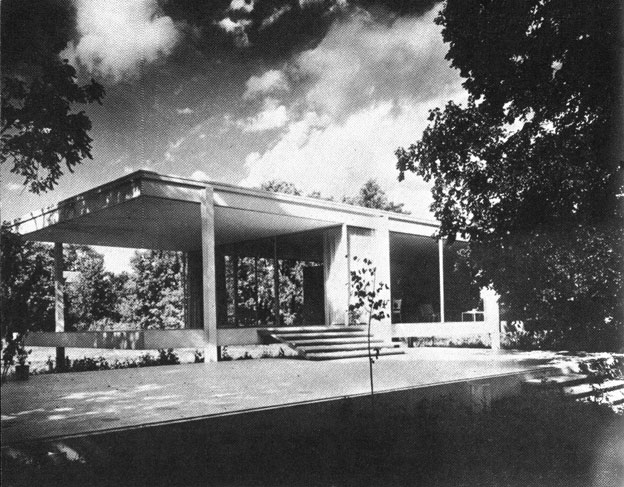
Farnsworth House

|
Mies Van der Rohe's Farnsworth House is an icon of modernism but many interpret it superficially as a stylistic gesture - the creation of a 'look' - rather more than a philosophical statement. Mies is narrow minded and obsessive but he becomes a star because his mood spells zeitgeist. He frees himself as much as humanly possible from suppositions and reduces building elements down to the barest of forms. Nobody had made a buildings like that before nor ever again. He adopts the classical idea of beams and columns and dispenses with load bearing walls. The columns shoot out from the ground. The floor and the roof are suspended at determined levels on them. The columns terminate proud of the fascia on a protruding trim. A slim gutter runs the perimeter of the roof. The roof is flat. The structure, like it or not, is coherent. The minimalism is exasperating but there it is; architecture in its most essential. Mies is convinced that the 'essence' of architecture is its best part. He believes that all architecture perforce is an elaboration of its rudiments and not even his own powerful intellect could reduce a habitable building down any further, leaving the eaves looking, dare I say, rather traditional. A further encouraging aspect is that if an architecture student produced such a studio project now, he would be at odds with his professors, perhaps destined to a low grade, having to defend the rationalist position. The poor kid would be accused of lacking originality, for lacking a 'conceptual' model. He would be accused of not having studied, with sufficient conviction, Marxism and Derrida. His only defense might be to remember what he knows about Wittgenstein but then crucial moments pass by and the professors are listening to another student who is claiming to be living a 'dream'. As nostalgia builds for a simpler time, even within the narrow timeframe of the rise of modernism, could one ask whether the Farnsworth House is a traditional building? The structural members square off to gravity. It expresses a belief in an inextricable bond between architecture and reason. It wants to represent a cleansing moral force in the world thus representing a continuity with the enlightenment tradition. If the building leaks and if it is too cold inside in winter, obviously the imagery of the idealised does not fit its realised use. However as a product of reason, being that its constructional faults derive not from misguided principles but from inadequacies in technology, one can at least talk about Farnsworth House using normal language. |
Bevagna, 6 8 2010